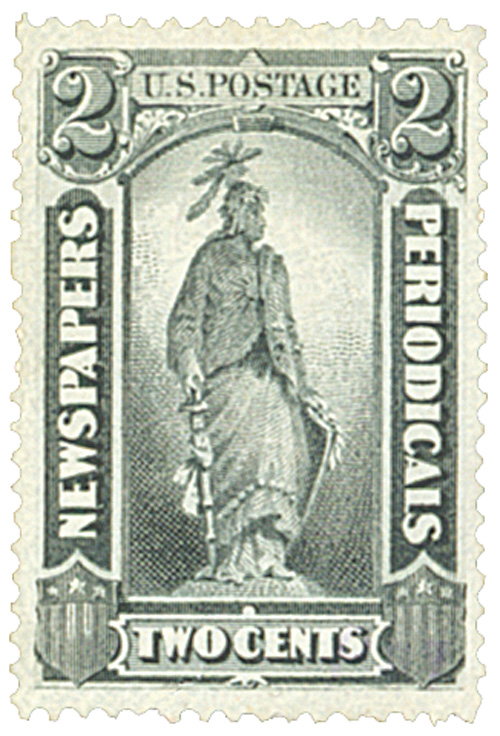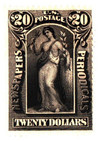
# PR123 - 1896 $20 Newspaper and Periodical Stamp, slate, watermarked soft paper
Scarce Newspaper and Periodical Stamps

Own Some of America’s Greatest Stamp Rarities!Â
Newspaper & Periodical StampsÂ

On March 3, 1863, an Act of Congress granted postal agents the ability to accept newspapers bundles, which would lead to the first US Newspaper and Periodical stamps two years later.
In the early days of the US Post Office, there was a rate of 1¢ per ounce on printed circular matter, making it expensive to mail newspapers and periodicals on a large scale. As a result, publishers turned to private express companies to deliver their printed material. But the Post Office wanted to get a share of the lucrative business.

So in 1863, the Post Office lowered its bulk rates for newspapers, and on March 3, Congress passed a new act. The act stated that “The Postmaster General may, from time to time, provide by order the rates and terms upon which route agents may receive and deliver, at the mail car or steamer, packages of newspapers and periodicals, delivered to them for that purpose by the publishers or any newsagent thereof, and not received from nor designed for delivery at any post office.â€

This act allowed postal employees who worked on trains or ships to transport shipments of newspapers, and then turn them over to the delivery service without the bundles going to the post office first. The fees for transportation were collected in cash. After about two years, postal officials realized that most of the money collected by their employees was never turned in. So in the summer of 1865, the Post Office introduced Newspaper and Periodical stamps to replace the cash system. The stamps were an accounting system that kept employees honest and helped the Post Office Department profit.

The new stamps were large and colorful, so they could be easily spotted on the packages of periodicals. Because they were placed right on the packaging, they were usually thrown away when the bundles were unwrapped. Elaborate designs prevented forgery and made them some of the most beautiful stamps ever issued.

In 1869, the Post Office Department stopped using the stamps and went back to the system of paying with cash. However, after just five years, the postmaster general estimated that about one-third of the money collected was never turned into the post office. So a call was made for new stamps to be produced. This time, the stamps weren’t put on the bundles of papers. Publishers would buy them in advance and give the proper amount to the postal clerk when they sent out their parcels. The post office employee gave a receipt to the publisher and put the stamps on the receipt stub. The stubs stayed at the post office until they were turned in for accounting then destroyed.

The new stamps pictured female allegorical figures like Freedom and Justice; goddesses from Greek mythology; and an Indian maiden on the highest denominations. The figures were meaningful symbols, as Congress felt newspapers and periodicals were important for an informed public, making a stronger democracy.
Over the years, the rate for sending newspapers dropped, to 1¢ per pound in 1885. This made it affordable to send newspapers and periodicals through the mail. This led to the creation of more newspapers, which linked citizens with their local and national government. On July 1, 1898, the use of Newspaper and Periodical stamps was discontinued and the stamps were demonetized.
Scarce Newspaper and Periodical Stamps

Own Some of America’s Greatest Stamp Rarities!Â
Newspaper & Periodical StampsÂ

On March 3, 1863, an Act of Congress granted postal agents the ability to accept newspapers bundles, which would lead to the first US Newspaper and Periodical stamps two years later.
In the early days of the US Post Office, there was a rate of 1¢ per ounce on printed circular matter, making it expensive to mail newspapers and periodicals on a large scale. As a result, publishers turned to private express companies to deliver their printed material. But the Post Office wanted to get a share of the lucrative business.

So in 1863, the Post Office lowered its bulk rates for newspapers, and on March 3, Congress passed a new act. The act stated that “The Postmaster General may, from time to time, provide by order the rates and terms upon which route agents may receive and deliver, at the mail car or steamer, packages of newspapers and periodicals, delivered to them for that purpose by the publishers or any newsagent thereof, and not received from nor designed for delivery at any post office.â€

This act allowed postal employees who worked on trains or ships to transport shipments of newspapers, and then turn them over to the delivery service without the bundles going to the post office first. The fees for transportation were collected in cash. After about two years, postal officials realized that most of the money collected by their employees was never turned in. So in the summer of 1865, the Post Office introduced Newspaper and Periodical stamps to replace the cash system. The stamps were an accounting system that kept employees honest and helped the Post Office Department profit.

The new stamps were large and colorful, so they could be easily spotted on the packages of periodicals. Because they were placed right on the packaging, they were usually thrown away when the bundles were unwrapped. Elaborate designs prevented forgery and made them some of the most beautiful stamps ever issued.

In 1869, the Post Office Department stopped using the stamps and went back to the system of paying with cash. However, after just five years, the postmaster general estimated that about one-third of the money collected was never turned into the post office. So a call was made for new stamps to be produced. This time, the stamps weren’t put on the bundles of papers. Publishers would buy them in advance and give the proper amount to the postal clerk when they sent out their parcels. The post office employee gave a receipt to the publisher and put the stamps on the receipt stub. The stubs stayed at the post office until they were turned in for accounting then destroyed.

The new stamps pictured female allegorical figures like Freedom and Justice; goddesses from Greek mythology; and an Indian maiden on the highest denominations. The figures were meaningful symbols, as Congress felt newspapers and periodicals were important for an informed public, making a stronger democracy.
Over the years, the rate for sending newspapers dropped, to 1¢ per pound in 1885. This made it affordable to send newspapers and periodicals through the mail. This led to the creation of more newspapers, which linked citizens with their local and national government. On July 1, 1898, the use of Newspaper and Periodical stamps was discontinued and the stamps were demonetized.

















